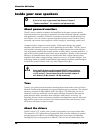
About the M1 Active
M1 ACTIVE REFERENCE MANUAL 11
along with the closed cell synthetic rubber surround, are both nearly impervious to
ozone, direct sunlight, heat and humidity. Therefore, after an initial break-in period
(about 20 hours), the sound should remain virtually unchanged for the life of the
product.
Alesis’ proprietary design tweeter features a pure Japanese silk dome, an internal
pole-piece mounted phasing plug and low viscosity ferrofluid formulated
specifically to retain the best balance of transient response to power handling. The
shielded tweeter utilizes a vented pole piece with a separate rear chamber to lower
the free air resonance. The very low 1500Hz crossover point of this tweeter produces
an extremely wide dispersion, low distortion signal within the critical midrange
frequencies. It is these frequencies which are often the most problematic in terms of
getting “right” during a mix. The tweeter is designed for an optimal response for
non-fatiguing, long term, high level, nearfield mixdowns. This design results in a flat,
linear mix when played back on home or car systems from appropriate distances.
Magnetic shielding
Your M1 Actives are at home in recording environments wherein video is a major
component. They are magnetically shielded for use in fairly close proximity (3”
minimum) to a computer monitor or video screen. (Non-shielded components can
make the colors of a screen “smear” or appear out of focus if the speaker is too close.)
Magnetic shielding was designed into both the woofer and the tweeter from the
beginning so that the system exhibits about 10 gauss (worst case) leakage. Shielding
of both the woofer and the tweeter is accomplished by the use of a second opposing-
field-oriented “bucking” magnet. The tweeter has an additional sixteen-gauge steel
cup encasing the entire magnetic structure.
The M1 Active bi-amplifiers & electronic
crossovers
The M1 active uses a 75W woofer amp and a 25W tweeter amp along with 8
th
order
high and low pass electronic crossover filters centered at 1500Hz. Electronic
crossovers, which separate the frequencies before being sent to the amplifiers, have
fewer phase problems and less power loss than the traditional passive crossover used
after the amplifier. Eighth-order filters are extremely steep (48 dB per octave), which
minimizes the interaction between woofer and tweeter near the crossover point.
Additionally, the high pass (tweeter) section of this system employs an electronic
time alignment circuit. Thus the “launch” of frequencies from both the woofer and
the tweeter will originate at exactly the same time.
There are several advantages to using built-in amplifiers and active (electronic)
crossovers versus a passive network system, most of which have been previously
enumerated in Vance Dickason’s “Loudspeaker Design Cookbook”:
• Lower intermodulation distortion due to amplifier operation over a more narrow
bandwidth. Also, clipping caused by low frequency overload is reduced, being
limited to only one driver within a two driver system.
• Increased dynamic range. The M1 Active’s 75W and 25W amplifiers in their bi-
amp setup will clip at about the same levels as one 200W amplifier operating into
a passive crossover.


















